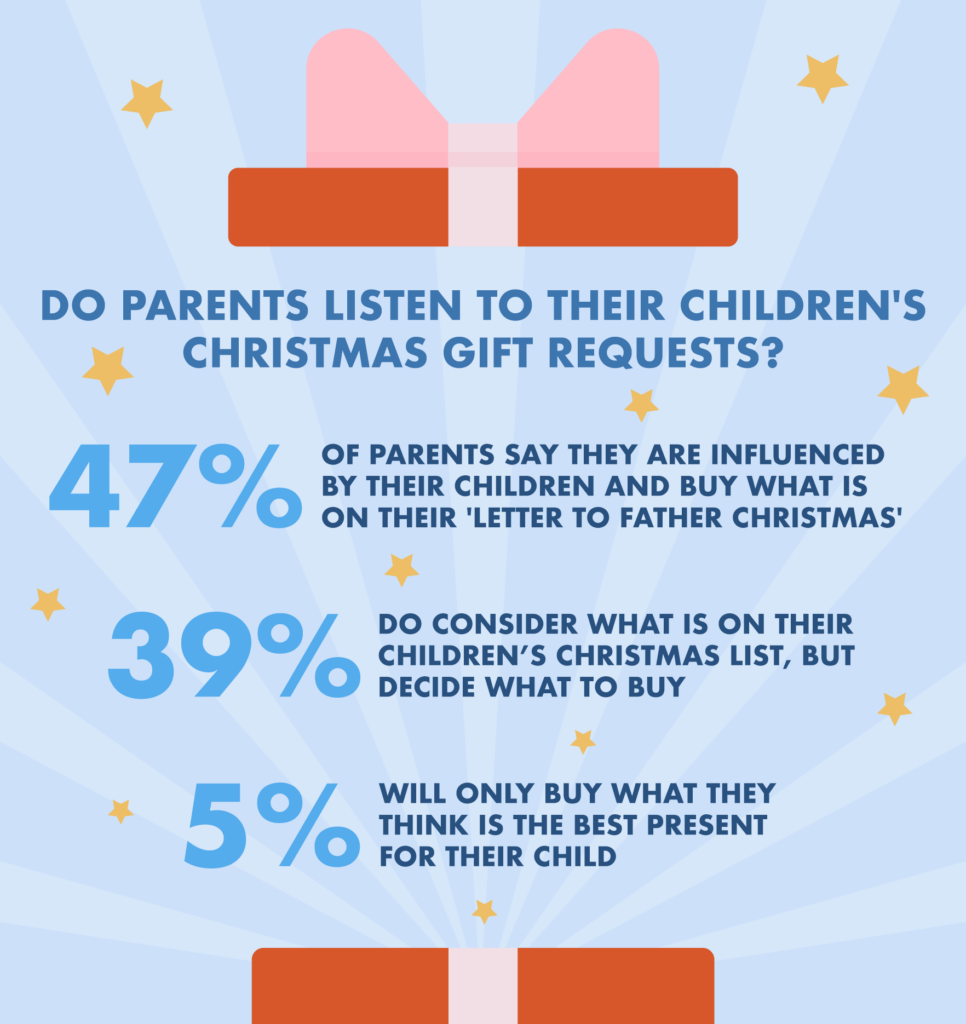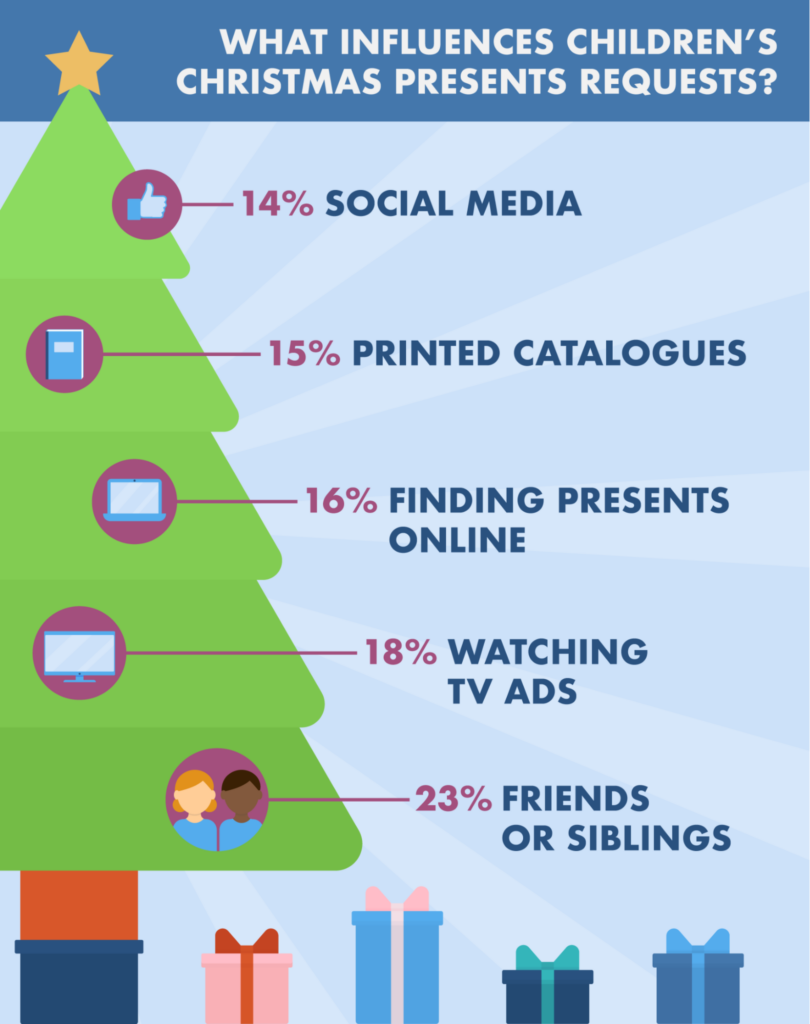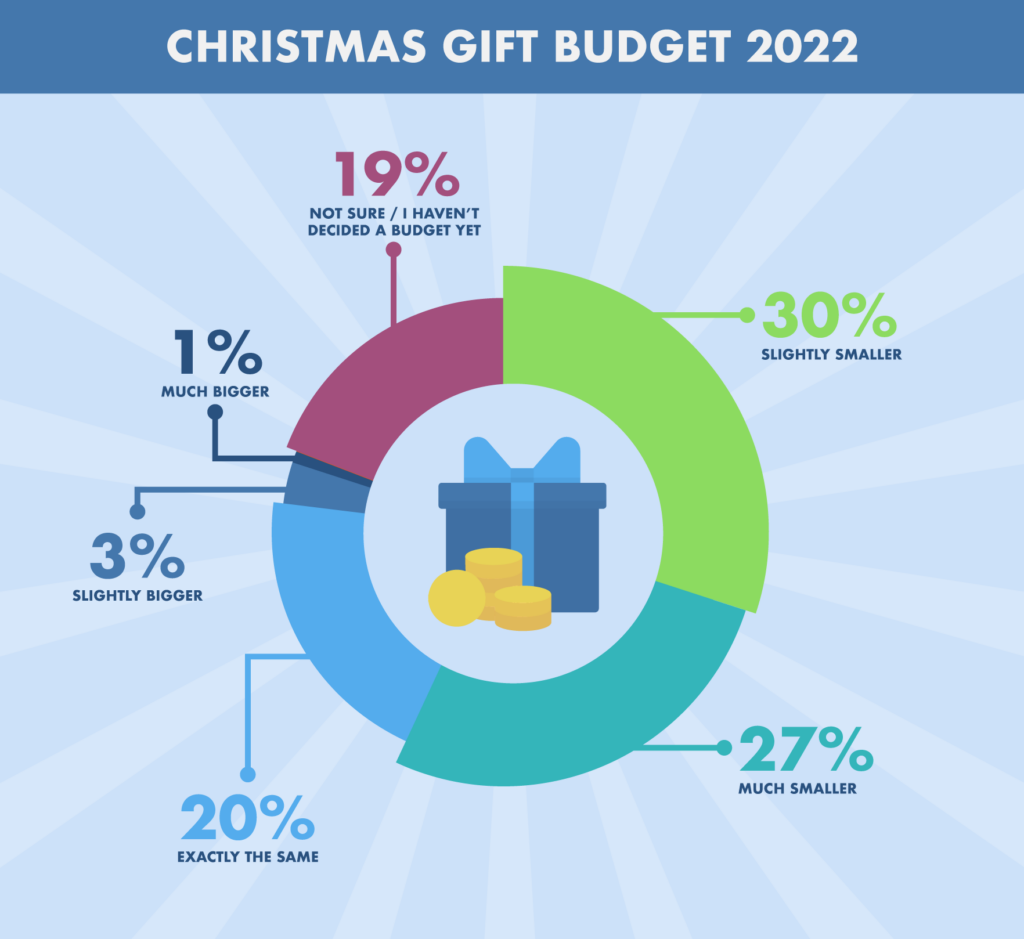
Christmas is such an exciting time of year, for children and parents alike! It’s the time of year to spend time with loved ones and exchange presents… but who really decides which presents are bought for children – parents, or the child themselves?
Each year, parents secretly wrap up presents to put under the tree and hope that their children love them, all without giving away any hint that they are actually ‘Father Christmas’. When it comes to buying presents for children, there are so many potential influences that can sway which present to buy – from social media to TV adverts and beyond – and parents and children track these influences differently.
Traditionally, parents would wrap presents from ‘Father Christmas’ and hide them under the Christmas tree without their children being any the wiser about what’s inside the wrapping paper. Today, however, children seem to have much more of a say in the gifts they receive. Long gone are the threats of Father Christmas’ “naughty list” – these days it seems like anything ‘elf on the shelf’ doesn’t see, isn’t noted – increasing present potential. When it comes to who gets the final say on Christmas presents, though, this falls on the person with the money. In most cases, this is still the parent.
To find out more about who the real decision-maker is when buying children’s Christmas gifts, we at Wicked Uncle investigated how much sway children have over their parents’ purchases.
We surveyed 1,000 parents in the UK with children under the age of 17 and asked them various questions about their Christmas gift-buying habits and decision-making process, in an attempt to determine how much their children’s wish lists determined their gift-buying decisions.
We also wanted to know where the most influence came from when it came to children deciding which presents to ask for – whether it was social media platforms like TikTok, ‘old-fashioned’ paper catalogues, TV adverts, or somewhere else.
Methodology
We conducted a survey of 1,000 UK parents with one or more children under the age of 17. The survey was conducted by OnePoll between the 3rd of November 2022 and the 9th of November 2022.
How much influence do children have on gift-buying?
In the months and weeks running up to Christmas, many children start to think about the presents they want to unwrap on the big day. These dream gifts are then typically either written in a letter to Father Christmas, put into a wish list for parents to reference when out shopping, or relentlessly relayed to parents in great detail on a daily basis.
We know that most children already know what they want for Christmas ahead of time, but we wanted to find out how much parents pay attention to this, and how much sway it has in the final decision-making process.
We asked parents how influenced they are by their children when it comes to buying them Christmas presents. Almost half of parents (47%) said that they were very influenced by what their children asked for or wrote in a letter to Father Christmas. Over half of these parents were male (64%), whilst just 30% were female.
39% said that they were slightly influenced by what their children wanted, but ultimately they made the decision based on what they thought their child would like the most. Half of the parents that admitted to being slightly influenced by their children were female (50%), whilst 27% were male.
Surprisingly, 5% of parents in the survey confessed that they don’t pay any attention to what their children ask for, and choose to only buy the presents that they think are best for their child. Christmas could prove to be a sad occasion in those households if the parents don’t get it right with their gift choices! A further 10% said they weren’t sure.

It seems that parents are more likely to be influenced by children between the ages of 6-11 (52%), whilst slightly fewer parents of children aged 12-15 purchased presents based on what their children asked for (37%), potentially due to a sudden influx of requests for certain expensive devices.
The most typical age group for children whose parents didn’t listen to their present requests at all was 0-5 years old (8%), which isn’t all too surprising if you cast your mind back to the kinds of things you expected Father Christmas to bring you at that age!
What influences children’s Christmas present requests
Unlike children of the near-past, children today have access to so many external factors that could influence what they ask for for Christmas – from social media and TV adverts to more traditional methods, like reading catalogues and window-shopping.
We wanted to find out where the most influence comes from when children are deciding what to ask for at Christmas time.
We asked parents what they believe influenced their children’s decisions the most when it came to asking for Christmas presents. Perhaps unsurprisingly, the majority (23%) said that their children were influenced by their siblings or friends when choosing Christmas presents. 18% said that TV adverts helped their kids decide what they wanted, whilst 16% credited Google and other online search engines.
15% of the parents asked said that their children used printed catalogues to pick out presents they liked, which was a pleasant surprise in the current digital age. For many of us, flicking through a toy catalogue and circling things we hoped Father Christmas would leave under the tree for us is one of our core memories of the Christmas season when we were growing up.

Surprisingly, when it came to hugely popular social media platforms like TikTok, just 14% of parents believed this is where their children’s Christmas present inspiration stemmed from. A further 14% didn’t align with any of the options given, whilst some parents provided answers of their own – which included their children seeing things in shops and pointing them out, window-shopping when visiting supermarkets, and finding things they like in a toy shop.
Catalogues were the most popular with children aged between 6-11 (17%), whilst TV adverts tended to be more influential to children between the ages of 0-5 (22%), 12-15 (21%), and 16-17 (22%). Social media’s influence on children’s Christmas present requests was quite even across the board, with 14% of almost all age groups taking influence from platforms such as TikTok, whilst surprisingly, just 11% of 16-17-year-olds took inspiration from this source.
Christmas budgets
Christmas shopping is notoriously expensive, leading to more parents starting to save up for presents earlier each year to ensure they have enough money to afford everything they want to buy for their family when that time of year arrives.
We asked parents if they had a specific budget for their children’s Christmas presents – and whether they have enough self-control to stick to their budget, if they have one! Just under half (44%) of the parents we asked said that they do have a budget for their kid’s presents, and they stick to it – they definitely have more restraint than us!
Of these parents, over half were male (53%), with 35% of female parents saying they stick to the budget.
26% said that they did have a budget in mind for their children when doing the Christmas shopping, but they always end up going over, whilst a further 30% admitted to not having a budget at all for their kids’ Christmas presents – lucky them!
Parents of children aged between 12-15 tended to be the most likely to go over budget (35%), whilst parents of children aged 6-11 were the least likely to go over budget.
Next, we wanted to know whether parents have made changes to their children’s Christmas present budgets compared to the previous year.
Unfortunately, the majority of parents said they had made present budgets smaller in some way this year, with 30% making the budget slightly smaller and 27% making it much smaller compared to last year. Male parents had made more cuts to Christmas budgets, with a combined percentage of 63%, compared to 51% of female parents.
Just 20% of the parents surveyed said their Christmas budget had remained the same as last year.
In general, very few parents have increased their budgets this year. 3% of parents said that their budget was somewhat bigger this year, and just 1% had made their Christmas present budget much bigger. A further 19% said they either weren’t sure or hadn’t decided on a budget yet.

Do parents buy presents based on gender?
Children’s toys and clothes have typically been designed with a particular gender in mind, and are usually colour-coordinated to represent this, based on historical stereotypes. In our modern society, where little boys and girls are generally encouraged to express themselves however they see fit and pursue any careers and hobbies that interest them, it is becoming increasingly common for parents to buy presents for their children regardless of the supposed target gender.
We asked parents whether they buy unisex or gendered presents for their children. 48% said that they bought gifts that were not gender-specific, with male parents making up a higher percentage (64%) than female parents (34%). Overall, this suggests that gendered presents might be becoming less of an issue, (or that dads might be wanting to play with their daughter’s Christmas presents!)
Just 26% of parents asked said that they bought presents for their children based on gender, of which 32% were female compared to only 19% male.
A further 26% said that they didn’t even think about whether presents were gender-specific or unisex.

We hope this survey has provided some insight into how parents make their decisions when it comes to buying Christmas presents for their children. Whilst we expected to see the majority of parents taking inspiration from their child’s requests, it was surprising to see that some parents choose to go at it alone and disregard what their children have asked for.
It was surprising to see that so few children are taking inspiration from popular social media platforms like TikTok, considering that the app was made popular by tweens and teenagers. Even in a world that sees phrases like ‘chronically online’ and ‘iPad kid’ being used to describe children spending all of their time online or with their heads buried in a tablet or phone, it seems that the majority of kids are still taking Christmas inspiration from more traditional sources.
The build-up to Christmas is one of the biggest shopping events of the year, so it’s no surprise to see that more parents are having to be strict with budgeting, particularly those parents that have had to reduce the amount of money they spend on presents at Christmas.
We were pleased to see so many parents being open-minded about buying presents that aren’t gender-specific, as specifically-gendered gifts seem to be continuing to fall out of popularity.



